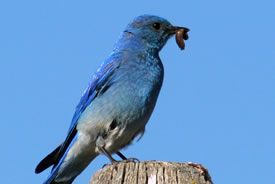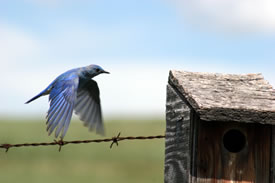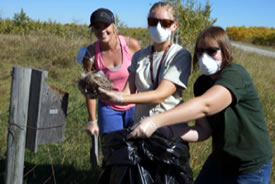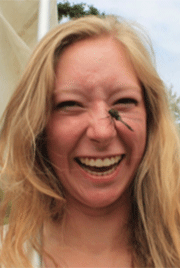Why bluebirds?

Mountain bluebird (Photo by Allison Haskell)
Why did I decide to write a blog about bluebirds? I am no bird specialist, that’s for sure, but I do think bluebirds are gorgeous. The first time I saw a bluebird was just 10 days after starting my internship with the Nature Conservancy of Canada (NCC). We were doing a site visit to our Nodwell property, more commonly known as Horseshoe Canyon, near Drumheller. As we pulled into the parking lot, we noticed a blue dot on the large NCC sign. It was a mountain bluebird. The shy bird flew away after only a few seconds, but the excitement of seeing such an iconic species for the first time is something that will stay with me.
Why write about bluebirds now?
In September, NCC, the Waterton Biosphere Reserve Association and the Wieners of Waterton hotdog shop teamed up to clean adjacent sections of highway bordering Waterton National Park. Keeping highways tidy helps to keep roadside garbage from getting into nature, including onto our properties, of which over a dozen in the Waterton area are separated from the highway by only five metres of buffer.
At lunch, all volunteers from all three groups gathered for a BBQ where we welcomed Gwen Tietz, a bluebird expert who has worked with a number of birding organizations across North America. Her passion for bluebirds, both for protecting and enjoying them, sparked my desire to write this post. Hopefully, this post will spark your love of bluebirds and make you want to help them too!

Mountain bluebird flying to box (Photo by Allison Haskell)
Why build bluebird habitat?
We should build bluebird habitat because so much of their original habitat has been lost. Bluebirds are shy; they don’t like to live in areas dense with people. They like to live in trees, and when folks moved out west, many cut down trees to make room for their cattle. By the 1960s, bluebird populations were dwindling because of lack of habitat.
The solution? Build man-made habitat for them! This was the reasoning of co-founders of the Mountain Bluebird Trails Conservation Society when they started making bluebird boxes that they would put out along scenic trails across southern Alberta and maintain at least once a year. And it worked! The populations came back because the bluebirds had places to build their nests and expand their population.
Today, with a growing human population and other land use pressures, we need to make sure that spaces remain available for these timid bluebirds.
It’s great news that the boxes program has been successful in the past. Now, its time to ensure that bluebird populations stay viable into the future! We need to maximize habitat for bluebirds because they are facing other threats in addition to habitat loss. For example, bluebirds are very similar in size to the invasive house sparrow. When these two birds compete for space the house sparrow will always win. Bluebirds are a prime example of why invasive species are the second highest cause of biodiversity loss, after habitat loss.
Additionally, baby bluebirds are very sensitive. Even melted snow dripping from the breast of a mother bird can give babies fatal hypothermia within a few hours. With increased uncertainty of when winter storms will hit, an example being the unexpected snow storm that hit Alberta in early September 2014, there is increased risk that vulnerable baby birds will have to fight to endure in the cold. Increasing the number of nests by expanding their habitat will increase the number of birds that will survive the storms.
What I’m trying to say that we need to make more bluebird habitat so that we can maximize the chances of these beautiful birds to thrive and have viable nests. I want my future grandchildren to see them.
How do you make bluebird habitat?
To make bluebird habitat, you need two things: a box and a good location.
Bluebird boxes have specific specifications that are important to follow. It is important to build and place bird boxes according to the specifications of each species. Even a small difference can make the box better suited for a different bird than the one you are trying to attract.
Instructions on how to make a proper bluebird box >
Location is also important for bluebird habitat. The boxes need to be at least 500 metres from buildings and facing away from roads.
More information on where to place your boxes >
If you don’t have a good location, I suggest donating your box to the Mountain Bluebird Trails Conservation Society. I'm sure they’ll find a good home for it!

Volunteers and NCC staff cleaning out a bluebird box along our adopted trail in Waterton (Photo by NCC)
How to help bluebirds if you aren’t handy
If you're not able to make and install your own bluebird box, there are many other ways you can help them. A great way is to adopt a trail from the Mountain Bluebird Trails Conservation Society. Adopting a route with family or a friend is a great way to bond and have fun in nature together!
If you find the idea of adopting a trail intriguing but want to try it out before you commit, you’re welcome to join NCC's Conservation Volunteers when we head to Waterton to take care of our own adopted trail. Keep an eye out for this event by checking our website, and signing up for our email list! The Conservation Volunteers Alberta newsletter comes out once per month between April and December.
If handiness and time are both limiting factors, a third way you can support bluebirds is through financial support. Supporting organizations that help bluebirds and conserve bluebird habitat is a crucial piece of this specie’s ability to thrive! The Nature Conservancy of Canada is one such organization.
Finally, an important way to support bluebirds is to talk about them. Get excited and challenge yourself to learn more about bluebirds, and tell your friends about them! An easy start is to tweet this article, share it on Facebook or tell a friend or family member about what you’ve just discovered about this well-loved animal.
Who knows, if you spread the word enough you might even get a bluebird box for Christmas that you can put up in the spring!


